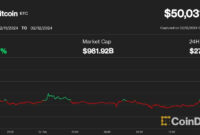Ethereum Continues to Sink Post-Merge: Down 18.5% in 3 Days – cryptokinews.com
Today could be one of the biggest days in crypto history, but you wouldn’t know it from the prices. The much-anticipated Ethereum (ETH) merge switches the biggest smart contract crypto from an energy intensive proof-of-work mining model to a much more efficient proof-of-stake system.
The merge has been compared to changing a car engine while speeding down a freeway, but that doesn’t really do it justice. Maybe it would be more accurate to say it’s akin to changing the engine on a plane that doesn’t have a pilot during a transatlantic flight. Whatever metaphor you use, it’s a big deal.
Why Ethereum’s price fell in spite of the successful merge
Given the enormity of the merge, some investors may have been surprised that Ethereum’s price fell today. It slipped over 7% in the hours immediately afterward. The trouble is that while the merge may be good for the popular crypto in the long term, it also caused a lot of short-term volatility.
There are a few factors at play, most notably the “buy the rumor, sell the news” phenomenon. This is where short-term traders speculate that the price of an asset will go up around a particular event. They buy in the months before the event, only to sell shortly before or immediately after it actually happens. Crypto and equity markets are also grappling with poor inflation figures and the potential for further interest rate hikes later this month.
In the long term, the merge could be transformative for Ethereum. Here are some of the reasons why:
- It cuts Ethereum’s energy consumption. The political spotlight is increasingly on the environmental impact of proof-of-work mining, and the merge takes the heat off Ethereum. It cuts Ethereum’s energy consumption by over 99%. That’s the equivalent of a country the size of Chile switching off its power completely.
- It paves the way for more improvements. This is a big step on a bigger journey for ETH. Next comes something called Sharding, which will make the network more scalable and lower gas fees. However, that won’t happen until next year at the earliest.
- ETH staking is here. Not only could the switch (along with other upgrades) eventually make Ethereum deflationary — meaning the number of tokens in circulation may decrease rather than increase, but investors will be able to stake their ETH and earn rewards.
Ethereum Post-Merge: Down 18.5% in 3 Days
Should you buy?
Cryptocurrency is a risky and volatile asset and there are no guarantees about how it will perform. If you’re considering buying crypto, whether it is Ethereum or another project, make sure you understand the risks, and only spend money you can afford to lose. Ideally, only invest a small percentage of your portfolio into crypto and put the rest into other assets such as stocks, real estate, or bonds.
Some may see the volatility around the merge as a great opportunity to buy Ethereum. If you’re in that camp, first make sure you are on top of other financial goals such as your emergency fund and retirement contributions. It is very early days for the crypto industry and it’s important to weigh the advantages of getting in early against the potential risks of a complete crypto collapse.
Ethereum is second only to Bitcoin (BTC) in terms of its market cap, and is way ahead of other crypto ecosystems in terms of the amount of money locked on its blockchain. According to DeFi Llama, Ethereum accounts for almost 60% of the value locked on all blockchain networks. The challenge is that other blockchains are taking market share because Ethereum still struggles with network congestion and high gas fees.
Ethereum could be a good long-term option, and it is certainly less risky than other small cap cryptos. But if it can’t reduce congestion and fees quickly, newer cryptos could take its crown. Earlier this year, an analyst at JPMorgan warned that Ethereum’s upgrades may come too late. Try to understand the potential pitfalls before jumping in.


